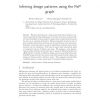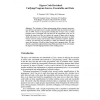179 search results - page 5 / 36 » An Extensible Tool for Source Code Representation Using XML |
78
Voted
IWPC
2003
IEEE
15 years 4 months ago
2003
IEEE
Parsing programming languages is an essential component of the front end of most program comprehension tools. Languages such as C++ can be difficult to parse and so it can prove ...
122
click to vote
EDBT
2004
ACM
15 years 11 months ago
2004
ACM
XML makes data flexible in representation and easily portable on the Web but it also substantially inflates data size as a consequence of using tags to describe data. Although many...
108
click to vote
JOT
2010
14 years 10 months ago
2010
Abstract Periodic refactoring of a large source code often becomes a necessity especially for long-lived projects. In order to increase maintainability and extensibility of such pr...
POS
2000
Springer
15 years 3 months ago
2000
Springer
Abstract. The technique of hyper-programming allows program representations held in a persistent store to contain embedded links to persistent code and data. In 1994, Connor et al ...
TOSEM
2010
14 years 10 months ago
2010
n the concept of abstract clone region descriptors (CRDs), which describe clone regions using a combination of their syntactic, structural, and lexical information. We present our ...


